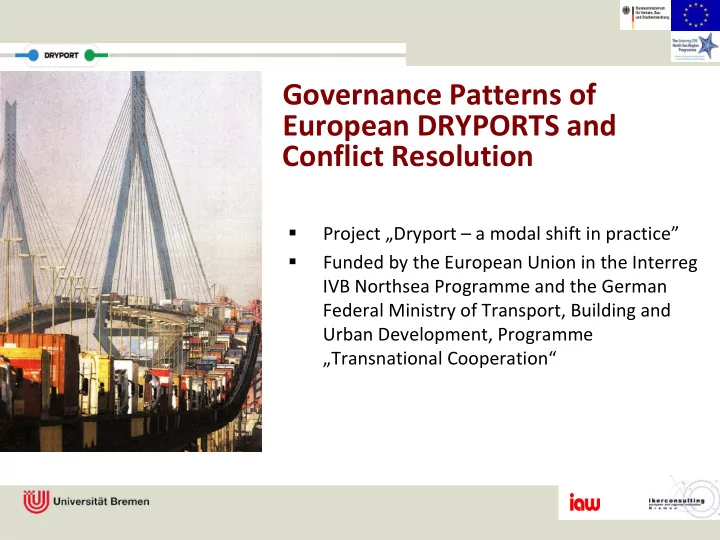

Governance Patterns of European DRYPORTS and Conflict Resolution Project „Dryport – a modal shift in practice” Funded by the European Union in the Interreg IVB Northsea Programme and the German Federal Ministry of Transport, Building and Urban Development, Programme „Transnational Cooperation“
Governance Patterns of European DRYPORTS and Conflict Resolution Dryports seem to be an answer, but what is the question? Which conditions would enable dryports to work as efficient partners for sea ports and as valuable options for sustainable logistics ? > Suggestions for efficient integration of dryports into logistic chains, regional structures and business strategies
Governance Patterns of European DRYPORTS and Conflict Resolution Concentration and competition through Containerization Growing Ship Sizes Container Turnover 2011 (in million TEU) Expanding World Rotterdam 11,9 Wide Trade Antwerp 8,5 Hamburg 9,0 Integration of Bremerhaven 5,9 logistics chains
Governance Patterns of European DRYPORTS and Conflict Resolution Consequences Congestion of port capacities and hinterland connections Lack of space / Missing options for expansion Land use conflicts / Restrictions by spatial planning Burden on environment Decreasing acceptance
Governance Patterns of European DRYPORTS and Conflict Resolution Expectations
Governance Patterns of European DRYPORTS and Conflict Resolution Four Cases in the North Sea Region Bremen/Bremer ‐ haven Gothenburg/Fal ‐ Gothenburg/ Falköping köping Haven Gateway Haven Gateway Bremerhaven/ Bremen Zeebrugge Zeebrugge
Governance Patterns of European DRYPORTS and Conflict Resolution Complex conditions for the function of dryports: Integration in logistic chains (functional dimension) Infrastructure (multimodal etc.) Spatial structure (freight village etc.) Connection to sea port (shuttle – rail or barge) Integration in regional structures (regional dimension) local content/added value spatial and environmental conditions job creation and generation of income Integration in business strategies (economic dimension) business models enterprise strategies competition vs. cooperation
Governance Patterns of European DRYPORTS and Conflict Resolution Multiplication of options for relevant stakeholders: Functional Integration Economic Integration (infrastructures, spatial (in stakeholder planning and structures, strategies, hinterland connection to sea port) connections etc.) Regional/political Integration Dryport (Economic impact on regional level, conflicts of interest: citizens, private sector, state)
Governance Patterns of European DRYPORTS and Conflict Resolution Key problem: Governance solutions for the integration of dryports Transfer of responsibilities for common interest to one of the involved partners (Zeebrugge) Establishment of new institution for management of cooperation (Bremen) Public authority to pull the strings (Falköping) Coordination left up to the market (Haven Gateway)
Governance Patterns of European DRYPORTS and Conflict Resolution Conclusion 1. Multiplication of options is a general aim 2. Competition between ports takes place in hinterland 3. Establishment and operation of dryports is a complex (triple) task of integration 4. Management of cooperation (governance) is essential
Governance Patterns of European DRYPORTS and Conflict Resolution Thank You! For further information ‐ www.dryport.org ‐ www.iaw.uni ‐ bremen.de Project Team Günter Warsewa gwarsewa@iaw.uni ‐ bremen.de Jochen Tholen jtholen@uni ‐ bremen.de Karsten Seidel karsten.seidel@ikerconsulting.com Manuel Kühn mkuehn@iaw.uni ‐ bremen.de
Recommend
More recommend